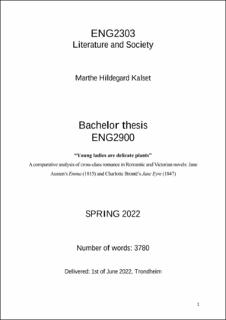| dc.contributor.advisor | Hacioglu, Yasemin | |
| dc.contributor.author | Kalset, Marthe Hildegard | |
| dc.date.accessioned | 2022-07-05T17:21:17Z | |
| dc.date.available | 2022-07-05T17:21:17Z | |
| dc.date.issued | 2022 | |
| dc.identifier | no.ntnu:inspera:106680562:37285618 | |
| dc.identifier.uri | https://hdl.handle.net/11250/3002875 | |
| dc.description.abstract | Mange av de litterære verkene vi i dag kjenner som klassikere ble skrevet og utgitt i løpet av 1800-tallet. Dette demonstreres i markedsføringen av den amerikanske bokhandleren Barnes & Noble's rekke av det de identifiserer som litterære klassikere: Barnes & Noble Classics (Barnes & Noble, n.d.). Barnes & Noble definerer bøkene på denne listen som “books that have changed history, inspired Hollywood, and entertained readers for centuries” (Barnes & Noble, n.d.). Vi finner både Emma (1815) av Jane Austen og Jane Eyre (1847) av Charlotte Brontë på denne listen, og kan derfor definere dem som klassikere fra 1800-tallet. Selv om de er skrevet i samme århundre, ble de ikke skrevet i samme litterære periode; Emma ble skrevet under den romantiske perioden, mens Jane Eyre ble skrevet under den viktorianske perioden. Blant flere andre temaer og elementer skildrer begge romanene kvinnelige heltinner, sosial klasse, karakterutvikling og romantikk på tvers av klasser. Jeg ønsker å se nærmere på det siste elementet i denne komparative analysen av Emma og Jane Eyre. Jeg vil bruke kritisk materiale for å skildre hvordan romantikk på tvers av klasser skildres i de to romanene, og på den måten identifisere likheter og forskjeller i hvordan romantikk på tvers av klasser skildres i Emma og Jane Eyre. Blant andre kritiske arbeider har jeg bestemt meg for å bruke Nilay Erdem Ayyildiz sin kritiske artikkel From The Bottom To The Top: Class And Gender Struggle In Brontë’s Jane Eyre (2017) som en sentral komponent i analysen da den diskuterer både klasse og kjønn. Jeg valgte også en sentral kritisk artikkel for Emma: The Labor of the Leisured in Emma: Class, Manners, and Austen (1999) av Jonathan H. Grossman, som påpeker hvordan klassesamfunnet fungerer i Emma. Det kritiske materialet jeg har valgt vil være en sentralt komponent gjennom analysen, da det vil gi analysen kritiske spørsmål og argumenter å diskutere. Det vil dermed fungere som en fordel for å underbygge argumentene jeg formulerer i forhold til forskningsspørsmålet mitt. | |
| dc.description.abstract | Many of the literary works we today recognize as classics were written and published during the 19th century. This is demonstrated in the marketing of the American bookseller, Barnes & Noble’s, range of what they identify as literary classics: Barnes & Noble Classics (Barnes & Noble, n.d.). Barnes & Noble define the books on this list as “books that have changed history, inspired Hollywood, and entertained readers for centuries” (Barnes & Noble, n.d.). We find both Emma (1815) by Jane Austen and Jane Eyre (1847) by Charlotte Brontë on this list and can therefore define them as classics from the 19th century. Even though they are written during the same century, they were not written during the same literary period; Emma was written during the Romantic period, while Jane Eyre was written during the Victorian period. Among several other themes and elements, the two books both portray female heroines, social class, character development and cross-class romance. I want to look further into the latter in this comparative analysis of Emma and Jane Eyre. I will use critical material to depict how cross-class romance is portrayed in the two novels, and in that way identify similarities and differences in how cross-class romance is depicted in Emma and Jane Eyre. Among other critical works, I have decided to use Nilay Erdem Ayyildiz’s critical article From The Bottom To The Top: Class And Gender Struggle In Brontë’s Jane Eyre (2017) as a central component in the analysis as it discusses both class and gender. I also chose a central critical article for Emma: The Labor of the Leisured in Emma: Class, Manners, and Austen (1999) by Jonathan H. Grossman, which points out the workings of class in Emma. The critical material I have chosen will be a central asset throughout the analysis, as it will provide the analysis with criticism and arguments to discuss and will work as an advantage to support the arguments I formulate in relation with the my research question. | |
| dc.language | eng | |
| dc.publisher | NTNU | |
| dc.title | “Young ladies are delicate plants”
A comparative analysis of cross-class romance in Romantic and Victorian novels: Jane Austen’s Emma (1815) and Charlotte Brontë’s Jane Eyre (1847) | |
| dc.type | Bachelor thesis | |
